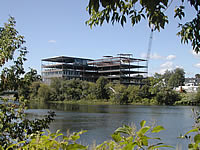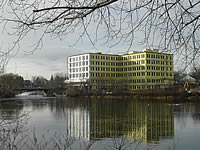Waste Site Cleanup & Reuse in New England
Riverwalk
Redevelopment in
Westbrook, ME
Success in the EPA Assessment Demonstration Grant Program
Westbrook, ME
(December 17, 2003)
|
||||||||||
On October 1, 2000 the city of Westbrook, ME was awarded $250,000 in an EPA Brownfields Assessment Demonstration Grant. The city has used the funding to assess several properties for environmental contamination as part of their downtown comprehensive plan for a “Riverwalk” redevelopment. The Riverwalk will involve the construction of several office buildings, some commercial business, a riverfront boardwalk, walking trails, greenspace with picnic tables and benches, and a bike path that will follow the Presumpscot River to connect with the neighboring Portland, ME bike path system. In April 2003, as part of the redevelopment plan, the city celebrated the groundbreaking for an office building and parking garage on two adjacent riverfront properties, 25 Bridge Street and 59 Dana Court . CORE, Inc. has committed to occupying the office space, relocating 375 employees to the downtown area.
The 135,000 square foot office building and 550-space garage was constructed by Tim Flannery, a local developer who owns Dana Warp Mill, a renovated mill building across the street from the new development. CORE, Inc. is a subsidiary of Fortis, Inc. and a for-profit business that works with employers and health care professionals to assist disabled or sick employees return to working after illness or injury. CORE will relocate 375 employees from all over the Northeast to the new facility, with plans to expand employment to 425. They also hold a lease option to expand across the street into Dana Warp Mill. The new building and Dana Warp Mill will be connected by a glass-enclosed walkway above street level. CORE, Inc. stated in a news article that the reasons for selecting the Westbrook location for the new facility was adequate office space and the flexibility were growth, convenient access for transportation, nearby amenities for employees, and the right price. The city had pre-established two tax incremental financing districts (TIFs) for the office building and the garage to help defray development costs, which allowed for lower lease prices to CORE. The city has leveraged $1M in federal highway funds and $250,000 in economic incentives to defray the $6M cost of the garage construction. The 550-space parking garage will have 100 spaces reserved for use by the public.
The property at 25 Bridge Street was first developed in 1868 by Westbrook Manufacturing Company. The company made duck, a heavy cotton cloth or canvas used for sails and tents. They also manufactured and dyed cloth for overalls. In 1885, the property had a large 4-story building with a wheelhouse and repair shop, a weaving building, three storage buildings, and a small shed. By 1903, S.D. Warren purchased the property and operated the S.D. Warren and Company Electric Light and Power Company, Westbrook Station No. 2. By 1909 Dana Warp Mill Corporation purchased the property and prepared threads for looms. The two western buildings were used by Graige / Conant Electric and the other two buildings were used for storage. Between 1922 and 1930 all the buildings were used for storage with a residence. In 1955 Stultz Electric Motor Company took over ownership of the property.
The former Foye Mill, on 59 Dana Court, was an 8000 square foot brick building constructed in the 1800s as a part of the Westbrook Manufacturing Company. C.E. Noyes bought the building and used it for a tire retread factory. Peter Foye bought it in 1984 and stripped the vacant buildings for lumber. In October 1992 the building burned down and all that remained was the filled-in foundation.
The two properties, a total of 1.67 acres, run along the shore of the Presumpscot River. The city worked with EER, Inc. as their environmental consultant. The total expenditure for environmental assessment was $65,000. The Phase II environmental site assessment revealed PCB levels in three transformers on the property that exceed ME DEP hazardous waste regulations. In the floor drains of the Stultz building, arsenic, lead, PCBs, and benzo[a]pyrene was determined to be at concentrations exceeding ME DEP regulations. EER, Inc. recommended remediation in the form of soil removal for these contaminants. It is also recommended that building debris form the former Foye Mill be removed. Vinyl chloride was found in the groundwater. Although the property receives water from the municipal system, it was determined that a deed restriction should be filed to prevent future drilling of wells for drinking water. The work will resulted in the owner receiving a Voluntary Response Action Program approval from the Maine Department of Environmental Protection.




